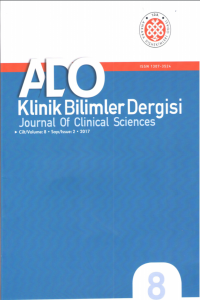Adezyon ve Rezin Simanlar
Dental adeziv, rezin simanlar, seramik
Adhesion and Resin Cements
Dental adhesive, resin cement, ceramic,
___
- Buonocore MG. A simple method of increasing the adhesion of acrylic filling materials to enamel surfaces. J Dent Res. 1955;34:849-53.
- Schwartz RS, Summit JB, Robbins JW. Fundamentals of Operative Dentistry: A Contemporary Approach. London: Quintessence Publishing Co, Inc.; 1996. p.141-186.
- Dayangaç B. Kompozit Rezin Restorasyonlar. 1. baskı. Ankara: Güneş Kitapevi Ltd. Şti.; 2000. s.1-18
- Şahin B. Estetik post sistemlerinin tutuculuğu üzerinde farklı yüzey uygulamalarının ve siman sistemlerinin etkisi [Doktora Tezi]: İstanbul Üniversitesi; 2009. s.36
- Anusavice KJ. Phillips’ Science of Dental Materials. 10th ed. Philadelphia: W.B. Saunders Co, Inc.; 1996. p.555-580.
- Craig RG, Powers JM. Restorative Dental Materials. London: Mosby Inc.; 2002. p.247.
- van Noort R. Introduction to Dental Materials. 2nd ed. New York: Mosby Inc.; 2002. p.257- 278.
- Van Meerbeek B, Lambrechts P, Inokoshi S, Braem M, Vanherle G. Factors affecting adhesion to mineralized tissues. Oper Dent. 1992;Suppl 5:111-24.
- Burke FJ, Qualtrough AJ, Hale RW. Dentin- bonded all-ceramic crowns: Current status. J Am Dent Assoc. 1998;129:455-60.
- Burrow MF, Tagami J, Negishi T, Nikaido T, Hosoda H. Early tensile bond strengths of several enamel and dentin bonding systems. J Dent Res. 1994;73:522-8.
- Van Meerbeek B, Lambrechts P, Inokoshi S, Braem M, Vanherle G.Enamel and Dentin Adhesion:Schwartz RS., Summit JB., Robbins JW. Fundamentals of Operative Dentistry: A Contemporary Approach. London: Quintessence Publishing Co, Inc.; 1996. p.146-186.
- 12. Van Meerbeek B, De Munck J, Yoshida Y, Inoue S, Vargas M, Vijay P, Van Landuyt K, Lambrechts P, Vanherle G. Buonocore memorial lecture. Adhesion to enamel and dentin: Current status and future challenges. Oper Dent 2003;28:215-35.
- Anusavice KJ. Phillips’ Science of Dental Materials. St. Louis: W.B. Saunders Co, Inc.; 2003. p.450-451
- Christensen GJ. Should resin cements be used for every cementation? J Am Dent Assoc. 2007;138:817-9.
- Summit JB, Robbins JW, Hilton TJ, Schwartz RS. Fundamentals of Operative Dentistry:A Contemporary Approach. 3rd ed. Chicago: Quintessence Publishing Co, Inc.; 2006. p.280- 288
- Roberson TM, Heyman H, Swift EJ, Sturdevant CM. Sturdevant’s Art and Science of Operative Dentistry. 5th ed. St. Louis: Mosby Inc.; 2006. p.216-229
- O’Brien WJ. Dental Materials and Their Selection. 3rd ed. Chicago: Quintessence Publishing Co, Inc.; 2002. p.132-156
- Radovic I, Monticelli F, Goracci C, Vulicevic ZR, Ferrari M. Self-adhesive resin cements: A literature review. J Adhes Dent. 2008;10:251-8. De Munck J, Van Landuyt K, Peumans M, Poitevin A, Lambrechts P, Braem M, Van Meerbeek B. A critical review of the durability of adhesion to tooth tissue: Methods and results. J Dent Res. 2005;84:118-32.
- Van Meerbeek B, Van Landuyt K, De Munck J, Hashimoto M, Peumans M, Lambrechts P, Yoshida Y, Inoue S, Suzuki K. Technique sensitivity of contemporary adhesives. Dent Mater J. 2005;24:1-13.
- Reis A, Pellizzaro A, Dal-Bianco K, Gones OM, Patzlaff R, Loguercio AD. Impact of adhesive application to wet and dry dentin on long- term resin-dentin bond strengths. Oper Dent. 2007;32:380-7.
- Dal-Bianco K, Pellizzaro A, Patzlaft R, de Oliveira Bauer JR, Loguercio AD, Reis A. Effects of moisture degree and rubbing action on the immediate resin-dentin bond strength. Dent Mater. 2006;22:1150-6.
- Spencer P, Swafford JR. Unprotected protein at the dentin-adhesive interface. Quintessence Int. 1999;30:501-7.
- Pioch T, Staehle HJ, Wurst M, Duschner H, Dörfer C. The nanoleakage phenomenon: Influence of moist vs dry bonding. J Adhes Dent. 2002;4:23- 30.
- Sano H. Microtensile testing, nanoleakage, and biodegradation of resin-dentin bonds. J Dent Res. 2006;85:11-4.
- ISSN: 1307-3540
- Yayın Aralığı: Yılda 3 Sayı
- Başlangıç: 2006
- Yayıncı: Ankara Diş Hekimleri Odası
Burcu GÖZETİCİ, Funda Öztürk BOZKURT
Özge PARLAR ÖZ, Aslı SEÇİLMİŞ, Cemal AYDIN
Dudak Parestezisine Neden Olan Radiküler Kist Bilimsel Mektup
Ülkem AYDIN, Nilüfer ÇELEBİ BERİAT, Yeliz KILINÇ, Selmi YARDIMCI YILMAZ, Nihal AVCU, Ar İlker CEBECİ, Kaan ORHAN, Meryem TORAMAN, Füsun YAŞAR, Mine CAMBAZOĞLU, Nuray ER, Erkan ERKMEN, Özgür PEKTAŞ, Metin ŞENÇİMEN, Ilgın AKÇAY, Hatice DOĞAN, Emel Olga ÖNAY, Cemal TINAZ, Zeliha YILMAZ, Ayşe Tuba Altu
Kayseri ve Çevresindeki Bir Grup Bireyin Diş Hekimliği Radyolojisi Farkındalığı
Emin Murat CANGER, Emre KÖSE, Büşra EKİNCİ
Tam Seramik Restorasyonlarda Yüzey Pürüzlendirme ve Polisaj
Hasan Hüseyin KOCAAĞAOĞLU, Hasan Önder GÜMÜŞ, Haydar ALBAYRAK
Anterior Diş Eksikliklerinde Fiberle Güçlendirilmiş Adeziv Köprü Uygulamaları: Üç olgu sunumu
Gülcan BAHADIRLI, Simel AYYILDIZ, Volkan TURP, Deniz ŞEN
Dudak Parestezisine Neden Olan Radiküler Kist
